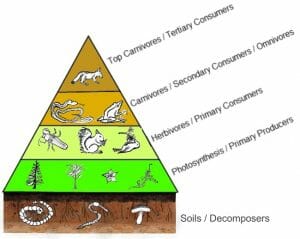Temperate Deciduous Forest Definition
A temperate deciduous forest is a biome that has many deciduous trees which drop their leaves in the fall. These forests are also known as broad-leaf forests because the trees have wide, flat leaves. Temperate deciduous forests lie in the mid-latitude areas of the Earth, between the Arctic poles and the tropics. These biomes are exposed to warm and cold air masses, causing them to have four seasons: winter, spring, summer and fall. As winter approaches and daylight decreases, the production of chlorophyll in the leaves slows and eventually stops, revealing the bright red, yellow and orange colors we associate with fall. Temperate forests began to form in the Cenozoic Era about 65.5 million years ago when the Earth began to cool. Tropical and subtropical forests are the other types of deciduous forests.
Temperate Deciduous Forest Location
The Earth’s temperate deciduous (broadleaf) forests are the areas shown in bright green in the map below. They are located in the eastern United States, China, Japan, Canada and Europe.
Temperate Deciduous Forest Animals
Insects inhabiting temperate deciduous forests include ants, flies, bees, wasps, cicadas, walking sticks, moths, butterflies, dragonflies, mosquitoes and praying mantises. Frogs, toads, snakes and salamanders are some of the reptilian residents of the temperate deciduous forest. Common birds found in this biome include woodpeckers, robins, jays, cardinals, owls, turkeys, hawks and eagles. Smaller mammals in the temperate deciduous forests include rabbits, otters, monkeys, beavers, raccoons, porcupines and squirrels. Bears, white-tailed deer, moose, tigers, elephants, giraffes, leopards, pandas and humans are some of the larger mammals that live in this biome.
In the temperate deciduous forest, there is a food web that consists of several trophic (food) levels. Each trophic level has organisms that have the same role in the food web. They also share the same energy sources. The trophic levels and the organisms living in each of them are shown in the image below. At the lowest level, the soil is full of earthworms, bacteria and fungi (called decomposers), which generate nutrients for organisms in the level above. The primary producers in the second level use these nutrients and sunlight to produce energy through photosynthesis. The next level up has the primary consumers, mostly herbivores, which consume the primary producers in the trophic level below them. In turn, the primary consumers supply energy for the secondary consumers (carnivores and omnivores) in the next level. The uppermost level of the trophic food web is home to the top carnivores, also called tertiary consumers. In addition, there can be a quaternary trophic level in more complex food webs. The food web ends when the animals at the top have no natural predators.

Temperate Deciduous Forest Plants
Temperate deciduous forests are home to trees such as oak, birch, beech, aspen, elm and maple. These tall trees form the forest canopy. Taller trees that stick up above the canopy are part of the emergent layer. After the canopy, the next layer down is the understory, which has smaller species of trees and younger trees that haven’t yet reached their full height. The shrub layer is next and contains woody vegetation such as bushes and brambles that grow in places where enough light comes down through the canopy. After this, comes the herb layer, consisting of soft-stemmed (herbaceous) plants including wildflowers, ferns and grasses. These plants must be shade-tolerant to live this far down in the forest. The last layer is the forest floor. This area of the biome has rich soil from decayed leaves, twigs, moss and animal waste, also called litter; this is the recycling area of the temperate deciduous forest. Earthworms, bacteria, fungi and insects are resident here, and their physical and metabolic processes keep the recycling going. Recent research has shown that decreasing leaf litter results in rapid loss of carbon from the soil.
Temperate Deciduous Forest Climate
Temperate deciduous forests have temperatures ranging from -22°F to 86°F. The average annual rainfall is 30 to 60 inches, with added precipitation falling in the form of snow. Temperate deciduous forests need at least 120 days without frost. Temperate deciduous forest canopies allow some sunlight to penetrate to the forest floor. This creates more plant and animal diversity than is found in tropic or subtropical deciduous forests, both of which have dense canopies.
Quiz
1. Temperate deciduous trees lose their leaves in which season?
A. Winter
B. Summer
C. Spring
D. Fall
2. Which layer of the forest has soft-stemmed plants?
A. The herb layer.
B. The canopy.
C. The forest floor.
D. The emergent layer.
3. Temperatures in temperate deciduous forests range from ___________________.
A. -22°F to 86°F
B. 65°F to 75°F
C. -5°F to 70°F
D. None of the above.
References
- Klappenbach, L. (2016, February 24). The structure of a forest. The layers of vegetation in a forest. Retrieved from https://www.thoughtco.com/structure-of-a-forest-130075.
- Temperate forest. (n.d.). In Encyclopedia Britannica online. Retrieved from https://www.britannica.com/science/temperate-forest.
- “Temperate deciduous forest.” (2017, May 8). Retrieved from https://earthobservatory.nasa.gov/Experiments/Biome/biotemperate.php.
- Zamboni, J. (2017, May 8). Plants and animals in deciduous forests. Retrieved from http://sciencing.com/plants-animals-deciduous-forests-7437021.html.
- Zinni, Y. (2017, May 8). Insects in temperate deciduous forests. Retrieved from http://sciencing.com/insects-temperate-deciduous-forests-8692891.html.
